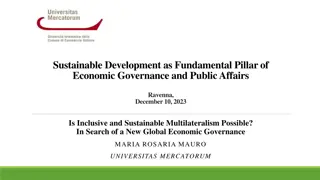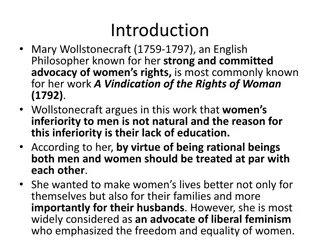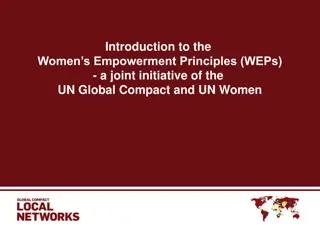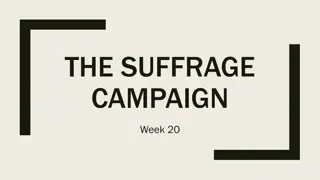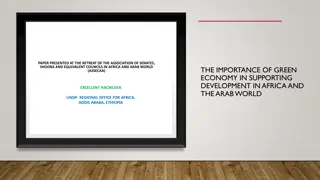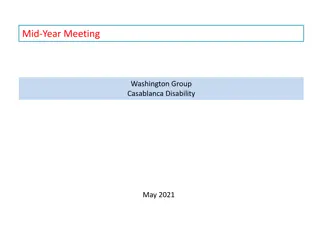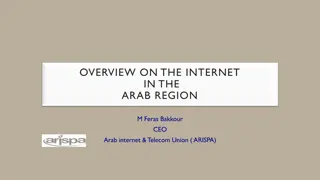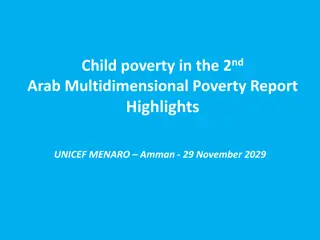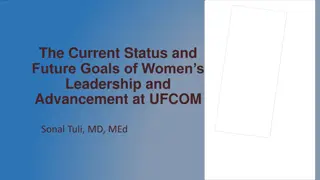Challenges and Opportunities for Arab Women in Sustainable Development
Arab women face numerous challenges in achieving full participation in sustainable development, as highlighted by the gender gap in various areas such as poverty, education, and access to resources. Empowering women and achieving gender equality are crucial for driving sustainable solutions to environmental, economic, and social issues. Addressing these disparities is essential for promoting inclusive and equitable development.
Download Presentation

Please find below an Image/Link to download the presentation.
The content on the website is provided AS IS for your information and personal use only. It may not be sold, licensed, or shared on other websites without obtaining consent from the author.If you encounter any issues during the download, it is possible that the publisher has removed the file from their server.
You are allowed to download the files provided on this website for personal or commercial use, subject to the condition that they are used lawfully. All files are the property of their respective owners.
The content on the website is provided AS IS for your information and personal use only. It may not be sold, licensed, or shared on other websites without obtaining consent from the author.
E N D
Presentation Transcript
Determinants of Arab women's full participation in sustainable development: Sustainable development goal 5 (SDG5) is a model Prepared by: Dr. Rula Al Farra Al-Haroob Chairwoman of Arab Women Parliamentarians Network for Equality "Ra'edat"
Why do we need to empower women and achieve equality? Empowerment of women is a precondition for sustainable development. Women take decisions that affect sustainable development and contribute to sustainable solutions to environmental, economic and social problems. When women and men have equal access to resources and opportunities to participate in decision-making processes, they become drivers of development by taking environmental, economic and social measures.
Gender gap in sustainable development: Figures showing the reality and identifying future development fields Women account for 50% of the world's total population and are often more affected by poverty and climate change , food insecurity, lack of health care and global economic crises than men. The number of poor women exceeds that of poor men, and families supported by women are poorer than those supported by men, which led to the emergence of the term "feminization of poverty". Women make up the bulk of unpaid labor, and their responsibilities that include housework and childcare limit their access to or maintenance of official paid jobs. The exclusion of women from the development process has led to the fact that 60% of the world's victims of malnutrition are women and girls In developing regions, maternal mortality rates are the lowest in developed countries (800 women die daily due to pregnancy and childbirth problems) 80% of the world's refugees are women and children Source: 2015 Arab Women's Organization Report, United Nations Women 2012.
Half of the world's women work three-quarters less than men, in addition to their domestic responsibilities 83% of home workers are women, and most of them do not receive minimum wages 60% of the world's illiterate women are women, while education is a prerequisite for ensuring gender equality and women's rights. Women are more exposed than men to the absence of social security. Statistics show that 75% of women's work in developing countries is in informal or unprotected businesses, or in unorganized sectors. -Women have less access to productive assets and therefore cannot benefit from them in such a way that enables them to participate effectively in the economy and achieve better developmental outcomes for their family and society. -Arab women contribute 25% of scientific research and technological development Source 2015 Arab Women's Organization report , UN Women 2012, ILO 2012
Gender gap in sustainable development: Figures showing the reality and identifying future development fields Women participate less than men in the labor market in most countries of the world. Low income countries (80% men and 70% women) Middle-income countries (75% men and 45% women) High-income countries (70% men and 50% women) The gap is higher in middle-income countries, including in the Arab region The gap in the unemployment rate among men and women is increasing with low income in the country The percentage of people with bank accounts growing annually, but the gender gap in the percentage of ownership of bank accounts increases with the low income in the country The percentage of women who work and get less or no pay is much higher than that of men Entrepreneurship among women varies widely among countries Source: World Bank, 2016
Gender gap in access to finance The data reveal a clear gap: Globally 7 percentage points In developing countries, 9 percentage points. Source: World Bank 2014
Participation of men and women in the labor force in the Arab region The "mystery" of the inverse relationship between progress in human development indicators and women's low economic participation is the dominant feature in the Arab region, But more clearly in Jordan Source: World Development Indicators, World Bank, 2013
participation of Arab women in two decades: - The average participation of women in the last two decades in the labor market has reached 10%, and this rate has risen significantly in the current decade to 23% But remains the lowest in the world s regions (Asia 65%, OECD countries 59% - If the growth rate of Arab women's participation in the labor market does not accelerate, they will not be able to catch up with western women until 150 years later. Source: World Development Indicators, World Bank (2011) (2016), Economic and Social Development Group Report , 2013, Women's Organization Report Less corrupt (However, caution should be taken when analyzing and analyzing these figures because female employment and intensity may be associated with work characteristics rather than gender of employer). Source: 2014 global Findex Report , International Labor Organization (2014), International Monetary Fund (2015)
Women in companies: Are there differences due to the gender of the owner, manager or board member? Organizations run by women or contributing to their governing bodies: More environmentally -friendly More committed to the rules of good governance More satisfying for employees and customers More profitable more capable to serve consumer markets dominated by women. -Employing more women, especially in leadership positions (the proportion of female employees in companies where women are employers is 21% compared to 16% in male-owned companies, and can reach more than 26% in companies where women are major shareholders).
Most Arab countries have made significant progress in the employment rates of women in the public sector, and women have occupied prestigious positions locally, regionally and internationally, but their access to senior management positions is far from achieving the fifth goal of sustainable development in the gender gap. Arab women s participation in leadership position stands at an average of 21.6%, and their contribution to the private sector is still low. Source: ( Joint Arab Economic Report issued in 2017) Arab women in business , professions and the public sector
Examples from Arab countries : Morocco: The percentage of women in the public sector is 38.6% in 2016 Bahrain: The average of basic salary of women in comparison with men aged 20- 59 years is increased in the public sector rose by 3.8% to 8% in 2016 UAE: The percentage of women who have their own companies or contribute in is 11.3% in 2016. They tend to business directed for consumer and personal activities, and do not prefer business services such as accounting, information technology, etc. GCC countries: The value of assets of small and medium-sized businesses run by businesswomen reached $ 385 billion in 2015, Women's labor force participation in the GCC increased to 32% in 2015; the percentage of women and business leaders( Entrepreneurs) in the GCC increased from 4% to 10% during the period from 2011 to 2014. source : Arab women report 2016
The importance of integrating woman in the seventieth goals of development 7
Determinants of women participation in sustainable development : What are the obstacles so ? Poor access of women to health, education and social services, poor infrastructure, clean water, sanitation and electricity services in some Arab countries, particularly countries that witness disputes and armed conflicts. Social culture: marriage + burdens and family restrictions + male standards. Lack of working conditions suitable for women: work timing and schedules, work place, means of transportation, their family obligations, nurseries, etc. Continued discrimination between men and women at work: private sector, wages, lack of access to positions, lack of involvement in training courses, early retirement, family allowances, etc
continued High rates of unemployment among girls, especially university graduates. The negative impact of expatriate labor on the opportunities of women and girls in the host country The household work and rural production are not taken in consideration as a contribution of women to the economy. Poor access to loans to finance projects, weak asset ownership (inheritance problem) Stereotypes in media, education, sermons and religious programs Illiteracy among women in the Arab region The spread of violence against women, which necessitated the adoption of many policies, laws and strategies to combat domestic violence and violence against women in a number of Arab countries, and the implementation of a number of national campaigns. There is no specialized body to deal with issues of discrimination or inequality in some Arab countries. The weakness of policies and legislation, and the absence of laws providing for equality in the Arab countries, although some constitutions are explicitly or implicitly stated for that, and although there are some strategies for women The absence of gender responsive budgets and budget balances in some countries Lack of gender balance in decision-making positions
Participation in political decision: Arab woman in the parliament
Policy work paper issued by the Arab Women Parliamentarians Network for Equality to raise the representation of women in leadership positions in political parties and electoral lists of parties. The equitable political positions require actions to: Raising the representation of women in the party's structures and its institutions. Provide financial resources for both men and women candidates of the party fairly. Changing cultural and social norms that consolidate stereotypes.
To achieve the above objectives, the Network calls for the following actions: 1-The establishment of committees for equality and equal opportunities within the structure of the party, whose task is to monitor the activities of the party to ensure the achievement of gender balance. 2. Provide additional financial incentives within the government support provided to the electoral campaigns of the parties and to the electoral lists that include 30% and more of the women in all elections held by the party , as well as additional financial incentives for the seats won by the party's candidates in parliament and in any of the elected councils 3. The party that does not meet the minimum standards of gender equality, in which two-thirds of its lists or candidates of one sex should be deprived from half of its funding allocated for electoral campaigns.
.4 Provide additional governmental financial support for party activities that achieve justice, equality and gender balance, whether within the cadres of the party or its electoral rules. 5. fixing ceilings for fundraising in election campaigns. 6. Defining ceilings for expenses on electoral campaigns 7. Set clear criteria that achieve transparency in fundraising and campaign spending. 8. Obligating the party to distribute its financial, human and other resources equally among the candidates of both sexes and provide evidence and link the violation of this commitment to the loss of the party's right to government funding. 9- The allocation of an additional funding share for the party, which includes 30% of the women members and more, and an additional funding share for the party, which includes 30% of the women in its higher leadership structures , as well as an additional share of the party headed
10- Correcting and revising educational curricula from what introduce negative or stereotypical images on women. 11. Employing civic and national education curricula to spread the culture of democracy and human rights. 12.Establishment of information centers to monitor the content published in traditional and alternative media and to publish reports and periodic studies showing the image of women in the media and monitor developments. 13. Obligating the official media institutions to adopt professional policies and charters that take into account the gender balance in the media content and stimulate private media institutions to adopt them.
14-The establishment of a women's fund in the ministries of information or culture whose task is to allocate financial incentives to media institutions in the private sector that contribute to changing stereotypes and providing leadership models for women. 15. Stimulating the departments of general statistics and research& studies centers to conduct gender studies to be as a variable for the study, in order to form databases that draw a clear picture of the relations of gender balance in all aspects. 16. Encouraging the private sector institutions and companies to promote social responsibility and allocate half of their donations and community grants in favor of empowering women through a package of incentives and tax exemptions. 17. Urging Ministries of Endowment And religious affairs to renew the religious discourse towards women, and to emphasize in the lessons, sermons and religious programs on the images , models and positive concepts on women and to promote fair representation of women in the leadership positions.
Representation of women in the leadership positions. Raising the rate of women representation in elected councils and councils of ministers (parliament, municipalities, local councils, professional and labor unions, chambers of commerce and trade) and boards of directors of public shareholding companies, the judiciary and administrative positions in higher education institutions. To achieve this objective , some actions have to be undertaken including the following : Imposing minimum number for women representation in case of list election system and minimum number of seats in the case of an individual election system, and the commitment of governments to gender-balance policies when appointed at higher positions, including the Council of Ministers and other leadership positions in the executive power ; In addition , the minimum level of representation of women should include other institutions such the boards of public shareholding companies, the deanships of faculties, the presidency of universities and higher institutes, and the judicial institutions, etc.
How much we have to wait for achieving equality and closing the gender gap? Globally: Although the fact that : The gender gap in health has been closed by 96% , and by 93% in education , but the gap in economic participation has been closed by 60% and the political participation gap has been closed by 21% only. Source: World Economic Forum Report 2013 . When do we achieve the fifth goal of sustainable development goals? Arab Women Parliamentarians network for Equality, with the support of UN Women, has set a goal for its members to seek to close the gap by 2030 through sincere and diligent work with parliaments, Arab governments and local, regional and international civil society organizations; This is in line with the goals of sustainable development of the United Nations and its agenda for all member States in the organization. Hand in hand to achieve the equity for a more secure, fair, prosperous, and peaceful world
) man ( + better in decision-making world woman




